FROM THE PRL / ORIGINALLY WRITTEN IN JAPANESE / C20TH / ASIA / JAPAN
“The novel has a timeless quality: The struggle of the individual to fit into a normalizing society remains just as relevant today as it was at the time of writing.”
William Bradbury, writing for the Japan Times, 2014
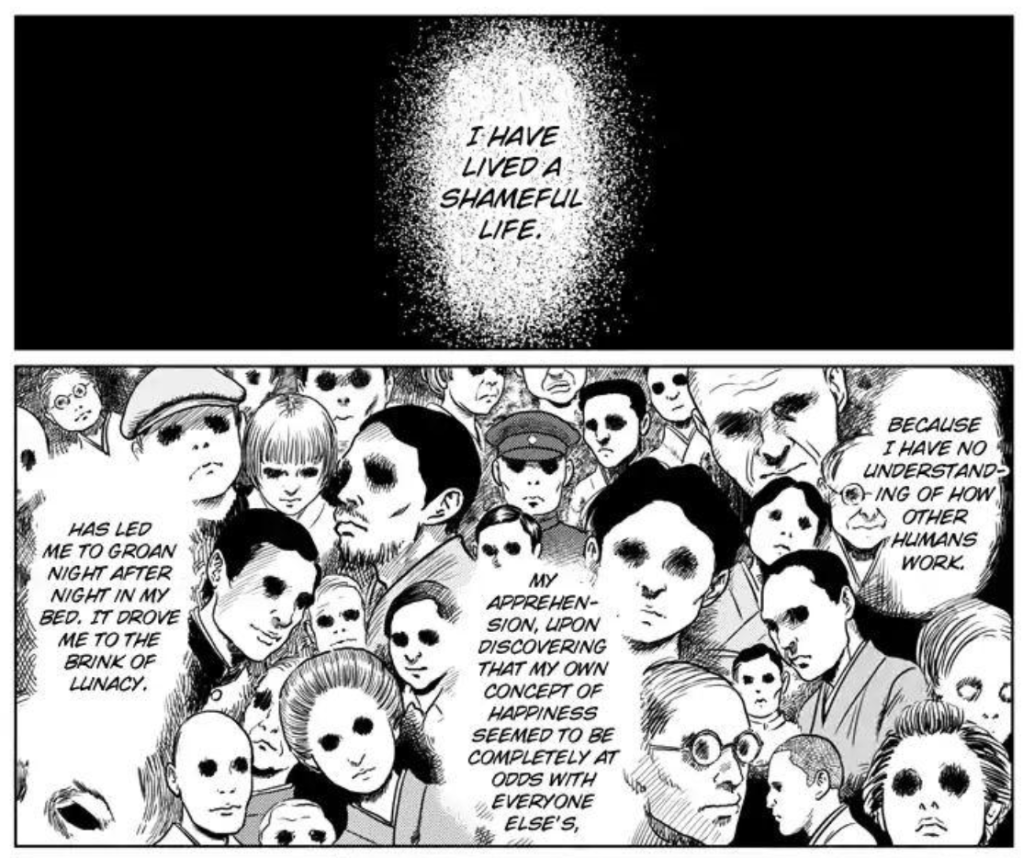
Introduction
The protagonist of No Longer Human, Yozo Oba, has a profound fear of other people. He is constantly suspicious and feels alienated from everyone and everything around him. The novel suggests that he was abused as a child, although his sense of alienation predates the sexual abuse he (may have) suffered at the hands of his father’s domestic servants. As a defence mechanism, Yozo learns to deceive people by adopting the persona of a clown. His outward shows of friendliness and good humour trick people into accepting him, but his clownish behaviour expresses nothing of his ‘true self’, which he keeps hidden away. Throughout the story, Yozo tries to find ways to express something of himself or simply get by in life: he learns to paint, pursues women, drowns his terrors with alcohol, and even tries to join the Communist party, an illegal act in Japan at this period in history. Yet, however hard he tries to escape reality, the results seem to get worse and worse. Eventually, Yozo tries to kill himself more than once, but always unsuccessfully – and each failure brings unexpected and disastrous consequences.
No Longer Human is the most famous of author Osamu Dazai’s (pen name of Shuji Tsushima, or 太宰治 in Japanese) few works. Written in 1948, it was first published in Japan under the name Disqualified From Being Human. Dazai’s book deals with themes of mental illness, depression, alienation, abuse, addiction, and suicide, seeming to uncover all of humanity’s darkest inclinations and tragedies. As a confessional work (in Japan, this type of autobiographical fiction is called an I-novel), the story echoes Dazai’s own unfortunate downward spiral. Yozo’s alcohol and morphine addictions, his failed relationships and attempted suicides all cleave close to Dazai’s real-life experiences. Just like Yozo, Dazai was unable to enjoy the fruits of his intelligence and success. Despite his novels being critically acclaimed and popular in Japan (and abroad) his ill health and series of personal failures set him on a path from which he was unable to recover: ultimately he abandoned his family and committed suicide with his lover, Tomie Yamazaki.
IB Student Learner Profile: inquirer
“
IB Learner Profile
Literature allows us to inquire into times and places that are different to those we may have direct experience of and to ask how we might form connections with people who seem alien to us. No Longer Human was written in Japan in the postwar years (the novel was first published in 1948) yet is set in the 1930s, a time in Japan’s history that has some very specific aspects of culture you should know about. In the build up to World War 2, Japanese culture was very nationalistic. Citizens were collectively expected to have a sense of patriotism and loyalty towards Japan. Therefore, Yozo’s feelings of suspicion towards his fellow humans sets him against society and marks him out as different. At one point he even joins the Communist party, which was an illegal act. Ironically, Yozo doesn’t care about Communism, and his involvement with this movement doesn’t last long, but his decision puts him further at odds with his own culture and country.
IB Lang and Lit Concept: identity
While undoubtedly a difficult read, No Longer Human is perhaps more relevant today than it has ever been. Yozo, the protagonist of the story, struggles to understand others and cannot form emotional connections. Constantly exposed to selfish, two-faced and even depraved people, he lives in terror of those around him. As a defence mechanism he affects a fake cheerfulness that he doesn’t really feel. In this way, Dazai lets us question the way we all project our identities in the way of a carefully rehearsed performance. After all, the millennial generation have learned the art of curating an idealised version of oneself on social media, creating ‘stories’ of ourselves that stand out but also conform. Like Yozo, sometimes it can be hard to tell where our masks end and our true faces begin…
Prologue and First Notebook
“I have always shook with fright before human beings.”
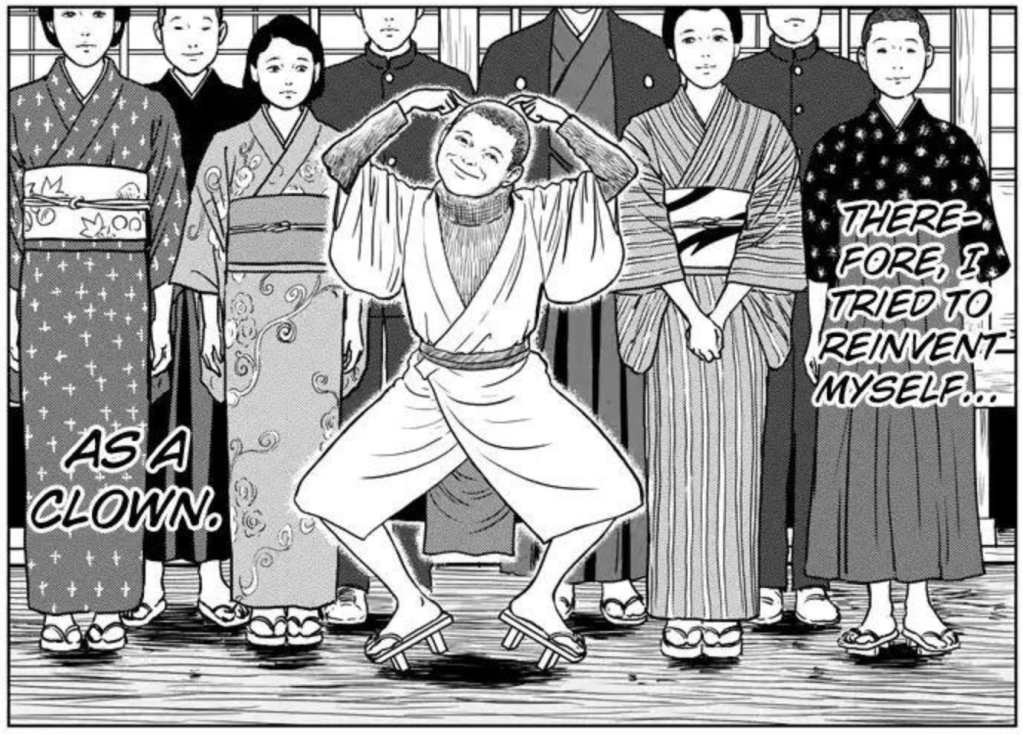
Yozo is the author of three notebooks that are passed to an unnamed narrator one day in a bar. The notebooks correspond to three periods of Yozo’s life: his childhood, teenage years, and life as a young man. The first notebook tells of how, at an early age, Yozo developed a deep and secret fear of other people. He is paralysed by indecision whenever anybody asks him to do something, longing to say ‘no’ but finding himself unable to reject anybody’s request. He also lacks the ability to relate to others, so cannot understand even the most obvious of motivations. Unable to connect, he learns to mask his neuroses behind the behaviour of a clown, spending most of his time with others playing the fool, making jokes – often at his own expense – and making people laugh. However, deep down he’s always afraid, and feelings of shame, alienation and terror dog him through his life.
The first notebook is prefaced with the unnamed narrator examining three photographs that were given to him along with the notebooks, each image corresponding to the same periods of Yozo’s life. The more he looks at the photos, the more the narrator feels that there’s something ineffably off-putting about Yozo’s appearance. He concludes that he’s a madman, and decides that there’s something unnatural about him – something that disqualifies Yozo from being entirely human.
Under the Mask
Dazai’s previous novel, The Setting Sun, published in 1946, shares some striking similarities with No Longer Human. The protagonist Kazuko, and her brother Naoki, are beset with anxiety and suffer from extreme feelings of mortal fear and shame.
Learner Portfolio: Practise for Paper 1 (Literature students only)
If you are a Language A: Literature student, at the end of your course you will sit Paper 1: Guided Literary Analysis. This paper contains two previously unseen literary passages. SL students write a guided analysis of one of these passages; HL students write about both passages. The passages could be taken from any of four literary forms: prose, poetry, drama or literary non-fiction. Each of the passages will be from a different literary form.
Here are two passages taken from the novel No Longer Human: the literary form is ‘prose fiction’. Each passage is accompanied by a guiding question to provide a focus or ‘way in’ to your response. Choose one passage and complete this Learner Portfolio entry in the style of Paper 1: Guided Literary Analysis.
Second Notebook
“It was with the sensation of treading on thin ice that I associated with girls. I could almost never guess their motives.”
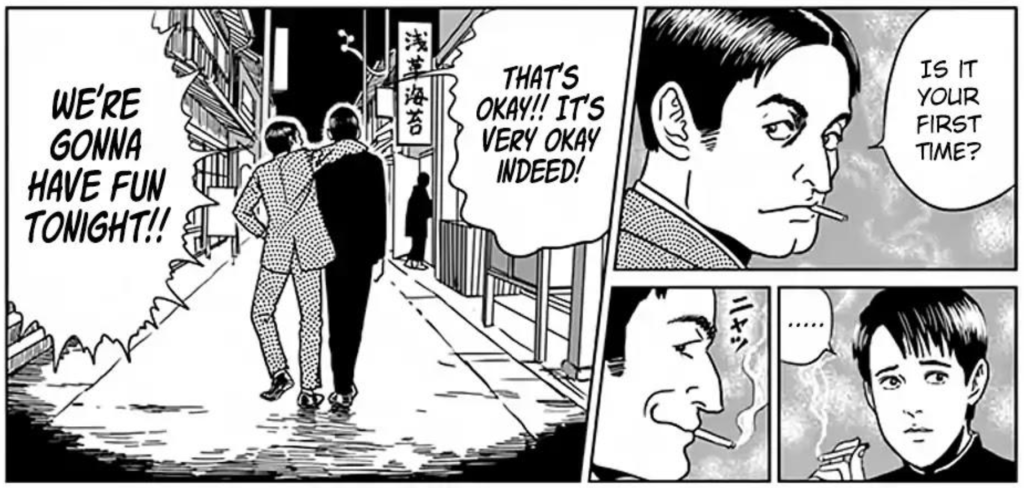
After enduring a childhood plagued by isolation, Yozo enters the final years of school. Actually, he has grown up into a handsome young man and, combined with his natural intelligence which earn him good grades, it seems like the world might be Yozo’s oyster. His clownish disguise is working well to keep people at a safe distance, and to cover up the debilitating horror Yozo feels in the company of others. But one day, his fragile equilibrium is nearly destroyed by a boy in his class called Takeichi who calls him out for acting foolish on purpose. Struck with mortal terror that Takeichi might reveal his secret, Yozo decides to befriend him in order to keep him close and guarded. But something good comes out of all this: it’s Takeichi who introduces Yozo to painting, something that Yozo finds he has a talent for. He learns to paint portraits of himself, that he calls ‘ghost paintings’, in an effort to express something of his true nature.
Following his newfound talent, after graduating from high school, Yozo attends art college. It’s here he meets his second friend, a man called Horiki Masao. Unfortunately, this prodigal wastrel leads Yozo into some bad ways, introducing him to drink and prostitutes. Under Horiki’s dubious tutelage, Yozo meets Tsuneko, hostess of a bar the two of them sometimes frequent. Yozo and Tsuneko have a one-night stand – then their relationship takes a decidedly strange turn indeed…
Resources
Under the Mask
The Japanese title of No Longer Human, Ningen Shikkaku, more accurately translates as ‘Disqualified From Being Human’. (The novel was also briefly published as ‘A Shameful Life’ in the 1950s.) What does the subtle discrepancy between the name in Japanese and English imply? Is there any meaningful difference between them?
Learner Portfolio: Dezai’s women
“I’ll bet lots of women will fall for you”
“Women are portrayed in a particularly positive fashion. They are thoughtful, intelligent, pensive, hard-working. This is in stark contrast to the majority of men: violent, alcoholic, selfish, addicted and womanizing.”
“The author, rather than using women to create a positive example of the modern Japanese female, was on the contrary simply simply utilising women as a tool to further view and critique [Yozo].”
Which of the two viewpoints of women in Dazai’s depiction of women do you agree with and why? Create a Learner Portfolio entry that investigates the role of women in Yozo’s life and in the novel as a whole. You could write an opinion piece, mind-map this topic, or work in small groups to prepare notes for a debate that you deliver in front of the class.
Third Notebook (Part 1)
“I frequently felt obliged to add… embellishment, out of a desire to please born of my usual desperate mania.”
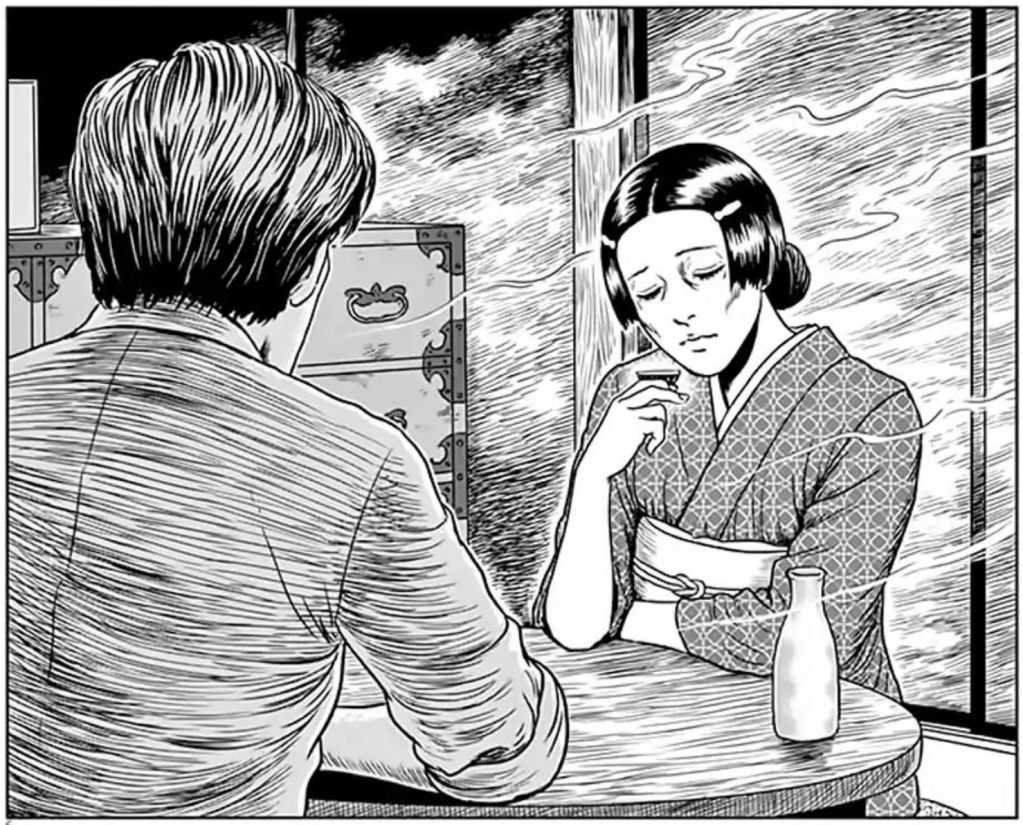
Following a disastrous double suicide attempt that Yozo survives, he is shunned by his family and expelled by his university. After being arrested and questioned, Yozo finds himself placed under the care of Flatfish, one of his father’s political fixers. While Yozo can’t stand this arrangement, he has no choice but to bear it… until he meets Shizuko, and moves in with her and her daughter. Once again, things seem to be looking up for Yozo, who finds a pseudo-family and becomes a moderately successful cartoonist. And once again his fear of others pushes him into drink and he eventually runs away from his happy life. Finally, he meets yet another young woman called Yoshiko who falls in love with him. The two agree to get married on the condition that Yozo quit drinking, which he tries – or at least pretends to try – to do.
Under the Mask
Whilst No Longer Human is set in 1930s Japan, it was written in 1946, as Japan was emerging from the ruins of World War 2. The dark, hopeless, and nihilistic tone of the novel perfectly captures the confusion of the postwar period, as the nation tried to come to terms with the past. Yozo’s self-destructive behaviour can be interpreted as a rejection of traditional values and a repudiation to the older generation.
Learner Portfolio: Practise for Paper 2
Write this Learner Portfolio in the style of a practice Paper 2 response. You can use one of the prompts below, or another prompt given to you by your teacher. Although Paper 2 requires you to write about two literary works, for the sake of this exercise you could focus only on your response to No Longer Human (visit this post for more help with Paper 2 literary compare and contrast skills). Choose one of the following prompts, talk with your teacher about how to approach and structure your writing, then complete your portfolio entry:
- How, and to what effect, are seemingly minor details resulting in major consequences presented in works of literature?
- Some writers shine a light while others criticise explicitly. Compare these different approaches in works of literature you have studied (or write about which approach you think Dazai takes in No Longer Human by itself).
- Identify some of the forms intolerance can take, and discuss how its effects on both the victims and the intolerant are presented in literary works you have studied.
- Judging by literary works you have studied, what would you say are the main causes of unhappiness?
Third Notebook (Part 2) and Epilogue
“I had now utterly ceased to be a human being.”
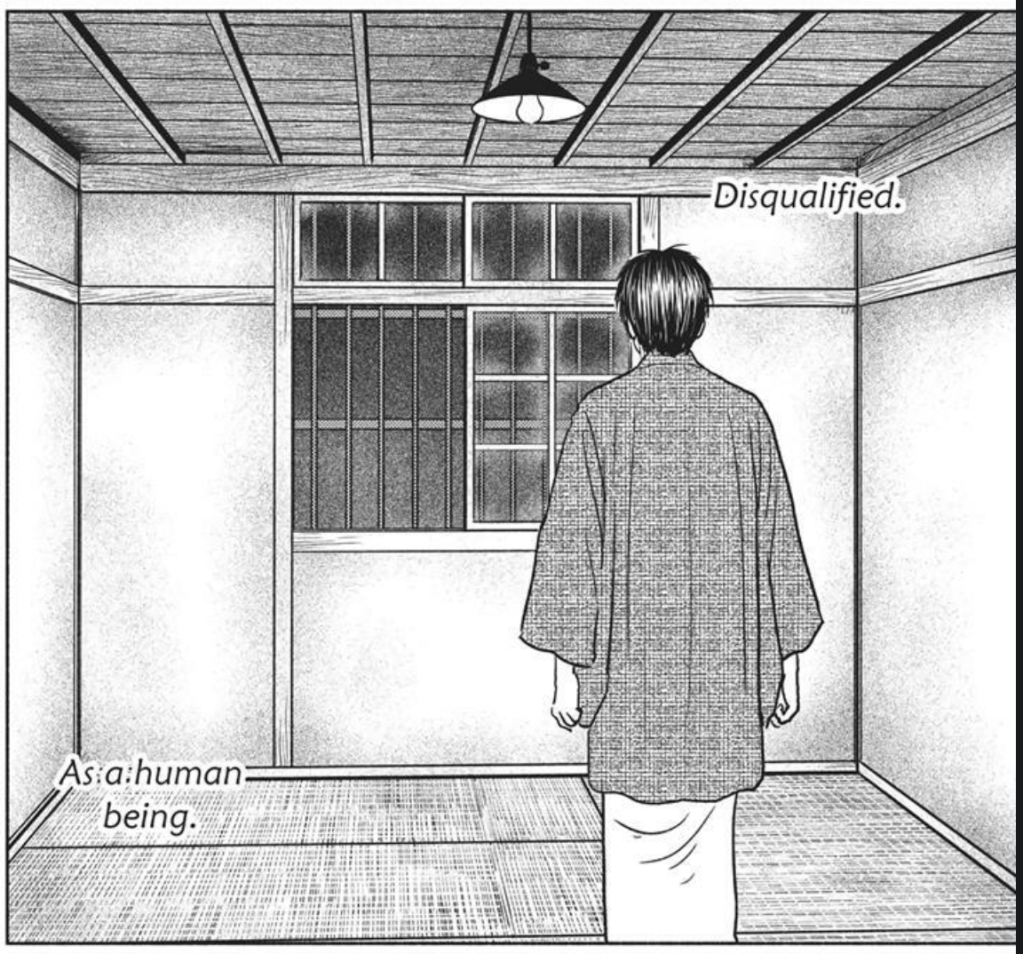
Whatever happiness Yozo finds in life never lasts long. Pretty soon, he falls back in with Horiki, who enables his relapse into alcoholism and drug addiction. One night, after an argument, Horiki taunts Yozo by leading him to the scene of Yoshiki being abused. Unable to recover from this shock, Yozo abandons Yoshiki and falls deeper into his depression, once more succumbing to the temptation to take his own life. Nothing seems to be able to reach Yozo now; medical treatment, recuperation, and even the support of Flatfish and the madame from the bar fail to do any good. Eventually Yozo is institutionalised in a mental asylum. Years later (although Yozo is only twenty seven years old by now) he is released to find that his father has died. Sent to live by the seaside with an older servant, Yozo is isolated, ostracised, and alone – truly now he is no longer a member of the human race.
After the third notebook ends, the reader is given one more brief scene of the unnamed narrator who has become intrigued by the notebooks and decides to use them as source material for a novel. Seeking more information about Yozo and the Oba family, the narrator questions the bar hostess who gave him the notebooks. What she has to tell him is the final twist in this tale of woe…
Resources
Under the Mask
A new exhibition in Mitaka, the area of Tokyo where Dazai spent most of his life, has recreated Dazai’s study in a gallery of art. Among items visitors can view is the manuscript of No Longer Human.
Learner Portfolio: Yozo the contradiction
Early in the story, Yozo’s father goes on a business trip and asks all of his children what they would like to receive as a present. Yozo has no idea what to say – nothing, he thinks, will make him happy. This incident shows how, even at a young age, Yozo had already disengaged from life and given up on himself. It’s easy to see how he might be destined to become ‘disqualified’ from the human race and he spends most of the novel trying to hide his true self from others.
Nevertheless, Yozo is an unreliable narrator, as proven by the epilogue which reveals his image of himself may not have been entirely true. Even the format of No Longer Human, a series of notebooks that he sent to a bartender he used to know indicates that, eventually, Yozo found the desire to open up and make connections with others. More obviously, his lifelong interest in art suggests that he yearns for some kind of expressive outlet despite his fears.
Create a piece of work (such as a character profile, chart, or mini-essay) that explores the character of Yozo, reveals some of his contradictions, and inquires into whether the idea that he has been ‘disqualified from the human race’ is entirely true. Ideas you might like to explore include:
- Yozo’s art
- Yozo’s opinion of himself
- Yozo’s desire to die
- Moments of happiness
- Yozo’s relationships with women
- His inability to stand up for himself
Towards Assessment: Individual Oral
Supported by an extract from one non-literary text and one from a literary work (or two literary works if you are following the Literature-only course)students will offer a prepared response of 10 minutes, followed by 5 minutes of questions by the teacher, to the following prompt: Examine the ways in which the global issue of your choice is presented through the content and form of two of the texts that you have studied. (40 marks)
No Longer Human could be a perfect text to choose when planning for your Individual Oral talk. Dezai’s themes touch on fields of inquiry such as culture, community and identity, dealing with issues of poor mental health, depression, addiction, suicide, and alienation. Once you have finished reading and studying this novel, spend a lesson working with the IB Fields of Inquiry: mind-map the notebooks, come up with ideas for Global Issues, make connections with other Literary Works or Body of Works that you have studied on your course. See if you can make a proposal you might use to write your Individual Oral.
Here are one or two suggestions to get you started, but consider your own programme of study before you make any firm decisions about your own Global Issue that you want to talk about. Whatever you choose, remember a Global Issue must have local relevance, wide impact and be trans-national:
- Field of Inquiry: Culture, Community and Identity
- Global Issue: the importance of support when suffering poor mental health
- Possible Pairings (Lit course: if you are following the Literature-only course, you must pair a text originally written in English with a translated work): A Thousand Years of Good Prayers by Yiyun Li; Life of Pi by Yann Martel; The Merchant of Venice by William Shakespeare; poetry by John Keats; poetry by Charlotte Mew; Top Girls by Caryl Churchill.
- Possible Pairings (Lang and Lit): I, Danial Blake by Ken Loach; The Waldo Moment by Charlie Brooker; Annihilation by Patton Oswalt; Eric Ravela’s Untouchables photographs.
Dazai’s novel deals with the ramifications of poor mental health. Possibly triggered by abuse he suffered as a child, Yozo retreats behind a fake personality. Yet all his efforts to cope are destined to fail, and he becomes more and more separated from reality, rationality, and society. Even more sadly, whether wittingly or unwittingly, at key moments of his life, those who might help Yozo cope better fail to offer him the support that he needs, driving him further and further away.
- Field of Inquiry: Art, Creativity and Imagination
- Global Issue: the power of art to reveal the truth
- Possible Pairings (Lit course: if you are following the Literature-only course, you must pair a text originally written in English with a translated work): poetry by John Keats; Waiting for the Barbarians by J.M. Coetzee;
- Possible Pairings (Lang and Lit): photographs by Alison Wright; Come to Selfhood by Joshua McFadden; Dove Real Beauty video adverts; Oliviera Toscani’s United Colours of Benetton campaign; editorial cartoons by Ann Telnaes.
It’s said that if you want fiction, study history; if you want the truth, study literature. How can it be that an imaginary medium can sometimes reveal more about the truth than any number of ‘facts’ can? Yet Yozo’s belief in the power of art to reveal the truth suggests just that. His ‘ghost paintings’ are the closest he gets to ever showing his true self.
Towards Assessment: Higher Level Essay
Students submit an essay on one non-literary text or a collection of non-literary texts by one same author, or a literary text or work studied during the course. The essay must be 1,200-1,500 words in length. (20 marks).
Once you’ve finished studying No Longer Human, and if you are an HL student, you might consider using this text to write your HL Essay. You can begin by considering one of the questions below, although remember to follow the direction of your notes and class discussions where you can:
- How does an analysis of Yozo’s character suggest an answer to the question of ‘nature vs nurture’?
- What is the role of the women in the story? Is it fair to criticise Dazai for his presentation and use of women characters?
- How does the framing device (unnamed narrator in the prologue and epilogue) lead your reaction to Yozo as the story unfolds?
- What is the role of society in Yozo’s downfall?
- Symbolism – No Longer Human is full of intereting symbols for you to investigate: animals, masks, photos and paintings, the kite. Develop a piece that explores the use of symbolism throughout the novel.
Categories:Prose